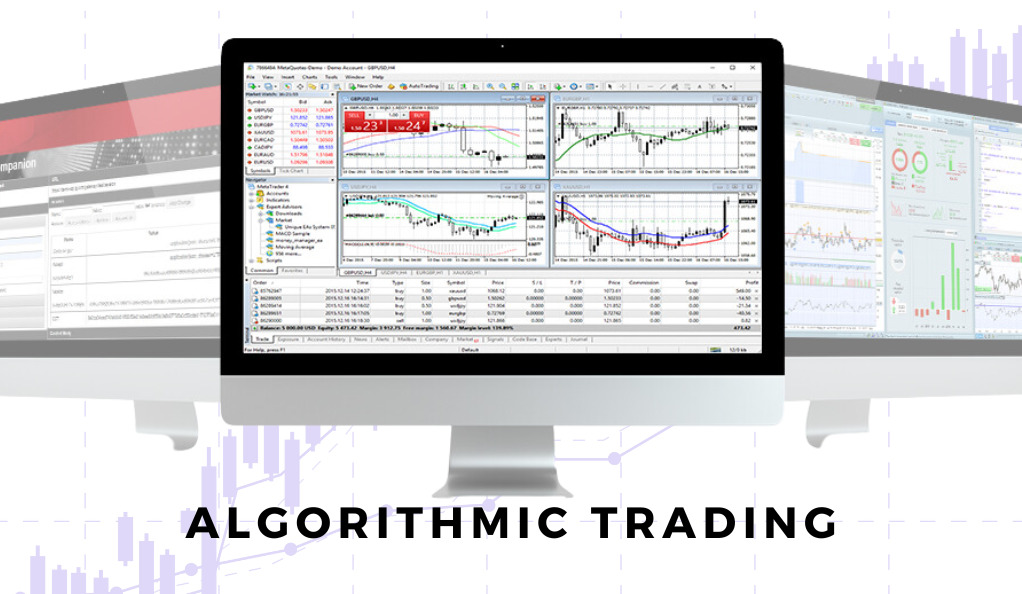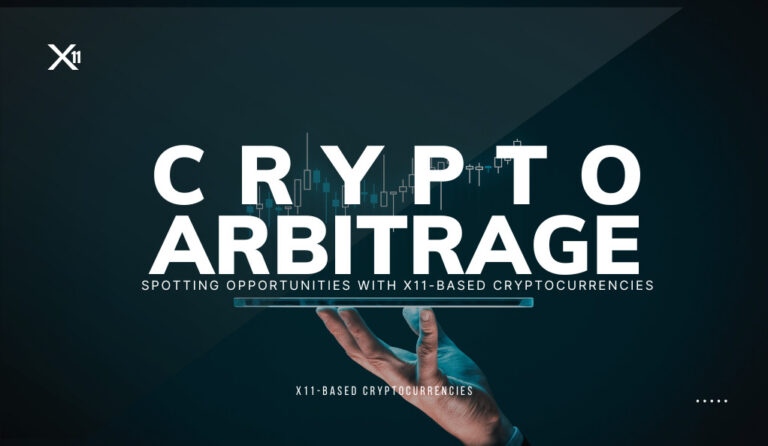In the dynamic world of finance, trading methodologies have evolved dramatically over the years, with technology playing a pivotal role in shaping new strategies. One such innovation that has revolutionized the trading landscape is algorithmic trading. But what exactly is it, and how does it fit into the realm of X11-based cryptocurrencies?
What is Algorithmic Trading?

Algorithmic trading, often referred to as “algo-trading,” involves the use of computer programs and systems to execute trades at a speed and frequency that would be impossible for a human trader. These algorithms are designed based on a set of predefined criteria, such as timing, price, quantity, and even complex mathematical models. The primary goal? To identify profitable trading opportunities in milliseconds and execute trades to maximize returns.
Key Features of Algorithmic Trading
| Feature | Description |
|---|---|
| Speed | Trades are executed in milliseconds, leveraging the computational power of computers. |
| Accuracy | Reduced risk of manual errors in placing orders. |
| Consistency | Algorithms operate based on set criteria, ensuring consistent trading decisions. |
| Scalability | Capable of analyzing vast datasets and executing multiple trades simultaneously. |
The Evolution of Algorithmic Trading
The inception of algorithmic trading began in the 1970s with the emergence of computerized trading systems, laying the groundwork for a technological revolution in the financial sector. However, its true potential was realized in the early 2000s, driven by the advent of high-frequency trading (HFT) and enhanced computational capabilities. This era marked a shift from traditional trading methods to rapid, computer-driven strategies, optimizing speed and efficiency.
Today, the influence of algorithmic trading is profound, with over 70% of trades on major stock exchanges being algorithm-driven. This dominance highlights the transformative power of technology in global finance, where algorithms have become indispensable tools for both institutional investors and individual traders, reshaping the landscape of modern trading.
Algorithmic Trading and Cryptocurrencies
Over the past decade, the explosive growth of cryptocurrencies has provided a fresh avenue for algorithmic trading. The inherent volatility of these digital assets, paired with their continuous trading cycle, positions them perfectly for algorithm-driven strategies. Specifically, X11-based cryptocurrencies amplify this allure, presenting unique opportunities within the crypto trading sphere.
X11-based Cryptocurrencies: A Primer

The world of cryptocurrencies is a diverse and expansive realm, characterized by a myriad of digital currencies each built upon distinct algorithms. These algorithms form the backbone of each cryptocurrency, determining its security, mining efficiency, and other vital attributes. Within this vast landscape, the X11 algorithm emerges as a notable contender. It distinguishes itself not only through its technical intricacies but also through the specific cryptocurrencies it underpins, showcasing a blend of unique features that set it apart in the crowded crypto arena.
Understanding the X11 Algorithm
X11 is a proof-of-work (PoW) algorithm that uses a sequence of eleven scientific hashing functions. This chain of functions enhances the security and complexity of mining, making it resistant to certain types of hacking attacks. One of the standout features of X11 is its energy efficiency. Compared to other PoW algorithms, X11 consumes less power and produces less heat, making it an environmentally friendly choice for miners.
Popular Cryptocurrencies Using the X11 Algorithm
Several cryptocurrencies have adopted the X11 algorithm, but the most notable among them is Dash (DASH). Dash was one of the early adopters of X11 and has since become one of the leading cryptocurrencies in terms of market capitalization and user adoption.
Leading X11-based Cryptocurrencies
| Cryptocurrency | Launch Year | Key Features |
|---|---|---|
| Dash (DASH) | 2014 | Private transactions, instant payments, decentralized governance |
| CannabisCoin (CANN) | 2014 | Catered to the cannabis industry, fast transactions |
| MonetaryUnit (MUE) | 2014 | Low transaction fees, fast confirmations, secure |
Why X11-based Cryptocurrencies Matter
The adoption of the X11 algorithm by these cryptocurrencies is not just a technical choice; it’s a strategic one. The energy efficiency of X11 ensures sustainable mining operations, while its security features offer protection against potential threats. Moreover, the multi-function hashing sequence of X11 provides a layer of future-proofing, ensuring that these cryptocurrencies can adapt to potential changes in the cryptographic landscape.
As the world of digital currencies continues to evolve, the significance of X11-based cryptocurrencies becomes even more pronounced. Their unique features, combined with the potential of algorithmic trading, open up a realm of opportunities for traders and investors alike.
Why Algorithmic Trading for X11-based Cryptocurrencies?
The integration of algorithmic trading with X11-based cryptocurrencies represents a deliberate and strategic convergence in the world of digital finance. These cryptocurrencies, underpinned by the X11 algorithm, bring forth unique attributes such as enhanced security and energy efficiency, making them stand out in the vast crypto ecosystem.
On the other hand, algorithmic trading, with its precision-driven approach, leverages technology to optimize trading outcomes. When these two forces merge, they form a powerful alliance. This combination not only amplifies the strengths of each component but also presents traders with unparalleled opportunities, harnessing the best of both technological innovation and financial strategy.
Unique Characteristics of X11-based Cryptocurrencies
X11-based cryptocurrencies, especially the likes of Dash, have certain attributes that make them stand out:
- Security: The multi-hash approach of X11 offers enhanced security against potential threats, making it a stable choice for trading.
- Speed: Transactions on X11-based networks are swift, ensuring that traders can capitalize on market movements in real-time.
- Sustainability: The energy efficiency of X11 ensures that the network remains sustainable in the long run, providing stability to traders.
Advantages of Algorithmic Trading in the Crypto Market
Algorithmic trading brings a set of benefits that can be amplified when applied to X11-based cryptocurrencies:
- Efficiency: Algorithms can process vast amounts of data quickly, identifying trading opportunities that might be missed by human traders.
- Precision: Trades are executed with pinpoint accuracy, ensuring that the desired trading strategy is followed to the letter.
- Emotionless Trading: Algorithms operate devoid of emotions, eliminating the risks of emotional trading decisions that can lead to losses.
- 24/7 Trading: Given the non-stop nature of the cryptocurrency market, algorithms can trade round the clock, ensuring no opportunity is missed.
Harnessing the Potential of X11-based Cryptocurrencies
The volatile nature of cryptocurrencies offers both risks and rewards. By employing algorithmic trading strategies tailored for X11-based digital currencies, traders can navigate this volatility more effectively. Whether it’s capitalizing on short-term price movements or hedging against potential downturns, algorithmic trading provides the tools to do so.
In essence, the marriage of algorithmic trading with X11-based cryptocurrencies offers a promising avenue for traders. It combines the best of both worlds: the advanced trading techniques of the financial world and the innovative features of the crypto realm.
Key Strategies in Algorithmic Trading

Algorithmic trading is not a one-size-fits-all approach. Depending on the market conditions, the specific cryptocurrency, and the trader’s goals, different strategies can be employed. When it comes to X11-based cryptocurrencies, certain strategies stand out for their effectiveness.
1. Systematic Trading for X11-based Cryptocurrencies
Systematic trading involves creating a comprehensive trading strategy based on statistical and mathematical models. For X11-based cryptocurrencies, this could mean:
- Trend Following: Capitalizing on the momentum of the market, buying when prices are on an upward trajectory and selling when they’re on a downward slope.
- Mean Reversion: This strategy assumes that prices will revert to their average over time. If an X11 cryptocurrency’s price deviates significantly from its historical average, a trader might buy or sell, expecting a return to the mean.
2. Market Making in the Crypto Context
Market making involves continuously buying and selling a cryptocurrency to profit from the bid-ask spread. Given the liquidity and speed of X11-based cryptocurrencies:
- Liquidity Provision: By offering both buy and sell orders in the market, algorithmic traders can earn the spread, especially in less liquid trading pairs.
- Inventory Risk Management: Algorithms can manage the inventory of held cryptocurrencies, ensuring that the trader isn’t overly exposed to drastic price changes.
3. Arbitrage Opportunities with X11 Cryptocurrencies
Arbitrage involves exploiting price differences of the same asset across different markets. With the global nature of cryptocurrency exchanges:
- Spatial Arbitrage: If an X11 cryptocurrency is priced differently on two exchanges, an algorithm can buy on the cheaper exchange and sell on the more expensive one, pocketing the difference.
- Triangular Arbitrage: This involves three trades, exchanging an X11 cryptocurrency for another, trading the second cryptocurrency for a third, and finally trading the third one back to the original. If the final amount is higher than the initial, a profit is made.
4. Trend Analysis and Predictive Modeling
With the vast amount of data available in the crypto market, algorithms can be designed to analyze trends and make predictions:
- Technical Analysis: Algorithms can be set to recognize patterns in price charts, such as head and shoulders, double tops, or moving average crossovers, to make trading decisions.
- Fundamental Analysis: For traders who believe in the long-term potential of certain X11-based cryptocurrencies, algorithms can be designed to analyze fundamental data like network activity, developer activity, and more.
In the ever-evolving landscape of cryptocurrency trading, staying updated with the latest strategies and tailoring them to the unique characteristics of X11-based cryptocurrencies can provide traders with a competitive edge.
Tools and Platforms for Algorithmic Crypto Trading
The success of algorithmic trading, especially in the realm of X11-based cryptocurrencies, heavily relies on the tools and platforms employed. These platforms not only facilitate the execution of trades but also offer a range of features that can enhance the trading experience.
Essential Features in Algorithmic Trading Platforms
When selecting a platform for algorithmic trading of X11-based cryptocurrencies, certain features are indispensable:
- High-frequency Trading Capabilities: Given the rapid price movements in the crypto market, the platform should be capable of executing trades at high speeds.
- Backtesting Tools: Before deploying an algorithm in the live market, traders need to test its effectiveness. Platforms should offer backtesting tools to simulate trading strategies using historical data.
- Security Measures: Given the digital nature of cryptocurrencies, platforms must prioritize security, including two-factor authentication, cold storage, and encryption protocols.
- User-friendly Interface: A clean and intuitive interface can significantly enhance the trading experience, especially for those new to algorithmic trading.
Leading Platforms for X11-based Cryptocurrency Trading
Several platforms cater specifically to the needs of crypto algorithmic traders. Some of the notable ones include:
- HaasOnline: Known for its advanced bots, HaasOnline offers a range of automated trading strategies. Its support for X11-based cryptocurrencies makes it a preferred choice for many.
- 3Commas: This platform offers a suite of tools, including portfolio management, automated trading bots, and strategy backtesting. Its integration with major exchanges ensures seamless trading of X11-based cryptocurrencies.
- CryptoTrader: A cloud-based platform, CryptoTrader supports automated trading bots and offers script editing for tailored strategies. Its support for X11-based coins adds to its appeal.
Custom Tools and Bots
For those with coding expertise, creating custom trading bots tailored for X11-based cryptocurrencies can be a viable option. Using languages like Python, traders can leverage libraries such as CCXT to connect with cryptocurrency exchanges and execute algorithmic strategies.
The tools and platforms chosen play a pivotal role in the success of algorithmic trading. By ensuring they are tailored to the unique needs of X11-based cryptocurrencies, traders can optimize their strategies and maximize potential returns.
Challenges and Risks in Algorithmic Crypto Trading
While algorithmic trading offers numerous advantages, especially in the volatile world of X11-based cryptocurrencies, it’s not without its challenges and risks. Understanding these can help traders navigate the crypto landscape more effectively and make informed decisions.
Market Volatility and Flash Crashes
The cryptocurrency market, by its very nature, is highly volatile. Rapid price swings can occur within minutes, leading to:
- Flash Crashes: A sudden and drastic drop in prices, even if temporary, can trigger stop-loss orders and result in significant losses for algorithmic traders.
- Whipsaws: Rapid price reversals can lead to false signals, causing algorithms to buy or sell inopportunely.
Technology and Infrastructure Risks
Algorithmic trading relies heavily on technology, and any glitch can have dire consequences:
- Software Bugs: An error in the trading algorithm can lead to unintended trades or missed opportunities.
- Connectivity Issues: A lost connection to the trading platform, even for a few seconds, can result in missed trades or failure to execute stop-loss orders.
- Platform Downtimes: Even the most reliable trading platforms can experience downtimes, affecting the execution of trades.
Overfitting and Backtesting Bias
While backtesting is crucial for validating trading strategies, it comes with its pitfalls:
- Overfitting: Tailoring an algorithm too closely to past data can make it less effective in real-time trading. An overfitted algorithm might perform exceptionally well in backtesting but fail in live trading.
- Data Snooping Bias: Continuously tweaking an algorithm based on comprehensive backtesting can lead to a strategy that’s inadvertently tailored to specific datasets, reducing its effectiveness in diverse market conditions.
Regulatory and Compliance Challenges
The regulatory landscape for cryptocurrencies is still evolving, and algorithmic traders need to be aware of:
- Regulatory Changes: Sudden changes in regulations can affect trading strategies, especially if certain trading practices are deemed non-compliant.
- Exchange Restrictions: Some exchanges might impose restrictions on high-frequency trading or certain types of algorithmic strategies.
Managing Expectations
Algorithmic trading, while powerful, is not a guaranteed path to profits:
- Unrealistic Expectations: Traders might expect consistent and high returns, but the reality can be different. It’s essential to have realistic expectations and understand that losses are part of the trading journey.
In light of these challenges, traders venturing into algorithmic trading for X11-based cryptocurrencies need to be well-prepared. Continuous learning, regular strategy evaluations, and staying updated with market and technological developments can go a long way in ensuring success in this domain.
The Future of Algorithmic Trading in Cryptocurrencies
The confluence of technology and finance has always paved the way for innovations, and algorithmic trading in the realm of cryptocurrencies is a testament to this synergy. As we look ahead, several trends and developments promise to shape the future of algorithmic trading, especially for X11-based cryptocurrencies.
Integration of Artificial Intelligence (AI) and Machine Learning (ML)
The next frontier in algorithmic trading is the integration of AI and ML:
- Predictive Analytics: Machine learning models can analyze vast datasets to predict future price movements of X11-based cryptocurrencies, refining trading strategies.
- Adaptive Algorithms: AI can help in creating algorithms that adapt in real-time to market changes, ensuring that the trading strategy remains optimal.
Decentralized Finance (DeFi) and Algorithmic Trading
DeFi is revolutionizing the financial landscape, and its intersection with algorithmic trading is inevitable:
- Liquidity Mining: Traders can use algorithmic strategies to optimize their participation in liquidity pools, maximizing returns from yield farming.
- Automated Market Makers (AMM): Platforms like Uniswap or Sushiswap rely on algorithms for price determination and liquidity provision, opening avenues for algorithmic trading strategies.
Quantum Computing and Cryptocurrency Trading
The advent of quantum computing promises to redefine computational capabilities:
- Ultra-fast Trading: Quantum computers can process information at unprecedented speeds, potentially taking high-frequency trading to the next level.
- Complex Simulations: Quantum computing can allow for more intricate backtesting and simulations, refining algorithmic strategies further.
Enhanced Security Protocols
As algorithmic trading grows, so does the need for robust security:
- Blockchain-based Trading Platforms: Leveraging blockchain’s inherent security features can lead to more secure trading platforms, minimizing risks of hacks.
- Advanced Encryption: With increasing threats in the digital realm, advanced encryption techniques will become integral to protect trading algorithms and strategies.
Global Regulatory Evolution
The global nature of cryptocurrencies means that regulatory developments in one region can impact markets worldwide:
- Unified Regulations: As the crypto market matures, there might be a push towards more standardized regulations, affecting algorithmic trading strategies.
- Transparency and Reporting: Regulatory bodies might mandate more transparent reporting mechanisms for algorithmic traders, ensuring fair market practices.
The horizon of algorithmic trading for X11-based and other cryptocurrencies is expansive and full of potential. By staying abreast of technological and market developments, traders can position themselves at the forefront of this evolving landscape, harnessing opportunities and navigating challenges with informed strategies.
Conclusion
The dynamic world of cryptocurrencies, particularly X11-based ones, offers a compelling canvas for algorithmic trading. With their unique attributes, these digital currencies, when paired with the precision and efficiency of algorithmic strategies, present a myriad of opportunities for traders. As the crypto landscape continues to evolve, staying abreast of the latest trends and technologies becomes crucial. Embracing algorithmic trading for X11-based cryptocurrencies not only provides a structured approach to navigate market complexities but also heralds a promising future filled with potential and innovation.
At axerunners.com, our goal is to furnish well-rounded and trustworthy information regarding cryptocurrency, finance, trading, and stocks. Nonetheless, we avoid providing financial advice and instead encourage users to conduct their own research and meticulous verification.
Read More











